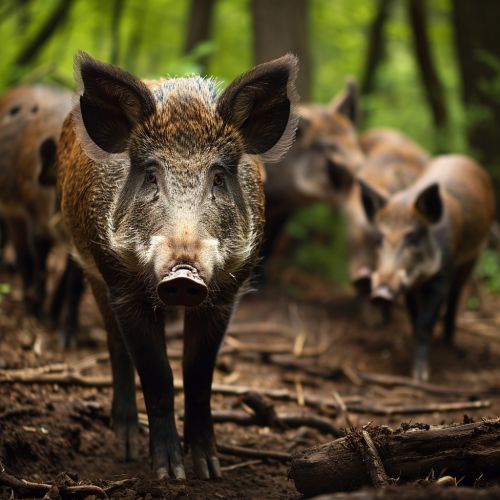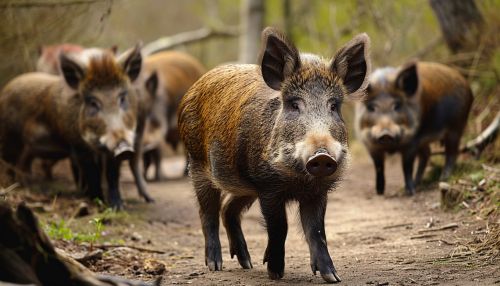Suidae
Taxonomy and Evolution
The family Suidae, also known as swines or pigs, is part of the order Artiodactyla, which includes even-toed ungulates. The family comprises 16 species divided into four genera. The oldest known Suidae fossils date back to the Oligocene epoch, approximately 34 million years ago, and are found in Asia and Europe. The family has since evolved and diversified into a wide range of forms and sizes, from the tiny Pygmy Hog to the large Wild Boar.


Characteristics
Members of the Suidae family are medium to large-sized mammals with robust bodies. They have a large head, short neck, and relatively short limbs. The snout is elongated and typically ends in a disc-like nose. The skin is thick and covered with bristles, and in some species, there are also sparsely distributed longer hairs. The coloration varies from species to species, ranging from light grey to brown or black. The dentition of Suidae is characterized by the presence of large, ever-growing canine teeth, known as tusks, in both males and females.
Behavior and Ecology
Suidae are highly adaptable and occupy a wide range of habitats, from dense forests and grasslands to arid regions. They are omnivorous, feeding on a diverse diet that includes roots, tubers, seeds, fruits, leaves, fungi, invertebrates, and small vertebrates. Some species, like the Warthog, are also known to consume carrion. Suidae are generally social animals, living in groups known as sounders. They have a complex social structure, with hierarchies established through aggression and submission signals.
Reproduction and Lifespan
The reproductive behavior of Suidae involves a gestation period that varies between species, ranging from 112 to 158 days. Females, or sows, give birth to a litter of piglets, which are precocial, meaning they are relatively mature and mobile from the moment of birth. The lifespan of Suidae also varies among species, with some living up to 25 years in the wild.
Interaction with Humans
Suidae have a long history of interaction with humans. Domestic pigs, descended from wild boar, have been kept as livestock for over 9000 years. They are an important source of meat, and their hides are used to produce leather. In some cultures, pigs also have symbolic or religious significance. However, some species of Suidae, particularly wild boars, can be problematic for human activities, causing damage to crops and occasionally attacking humans.
Conservation
Several species of Suidae are threatened by habitat loss, hunting, and diseases. Conservation efforts for these species include habitat protection, hunting regulations, and captive breeding programs. The IUCN Red List includes several Suidae species, with statuses ranging from Least Concern to Critically Endangered.
